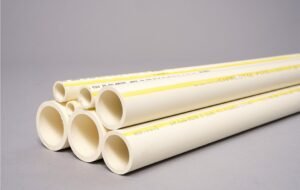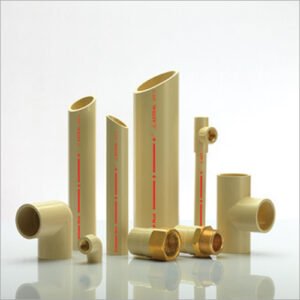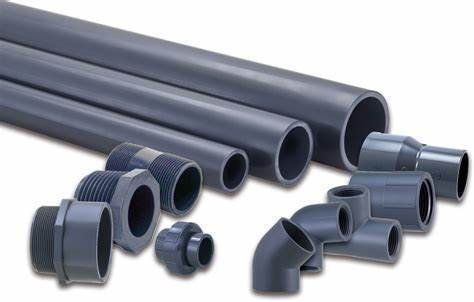Introduction: The Unsung Hero of Modern Plumbing
Plumbing isn’t glamorous. Until it fails.
Whether you’re building a home, remodeling a bathroom, or upgrading an industrial facility, your choice of plumbing material can make or break long-term efficiency and safety.
Enter the cpvc pipe—a quiet revolution in the world of water systems. Affordable, reliable, heat-resistant, and easy to install, it has become the preferred solution for residential, commercial, and even industrial plumbing.
But what exactly is a cpvc pipe? How does it differ from regular PVC? And is it the right choice for your project?
Let’s dive in.

What is a CPVC Pipe?
A cpvc pipe stands for Chlorinated Polyvinyl Chloride pipe. It’s a thermoplastic made by chlorinating PVC resin. This added chlorine gives CPVC higher temperature resistance, making it ideal for both hot and cold water applications.
Unlike traditional PVC, which is typically only used for cold water, a cpvc pipe can handle temperatures up to 200°F (93°C) without warping or degrading.
CPVC vs PVC: What’s the Real Difference?
| Feature | CPVC | PVC |
|---|---|---|
| Temperature Tolerance | Up to 200°F | Up to 140°F |
| Applications | Hot & Cold Water | Cold Water Only |
| Cost | Slightly Higher | Lower |
| Flexibility | More Flexible | More Rigid |
| Lifespan | 50+ Years | 25–40 Years |
If you’re planning a plumbing job that involves hot water—such as in bathrooms, kitchens, or industrial settings—a cpvc pipe is the smarter choice.
Key Benefits of Using a CPVC Pipe
1. High Temperature Resistance
A cpvc pipe remains stable even at high water temperatures, which is crucial for showers, washing machines, and industrial usage.
2. Corrosion and Chemical Resistance
It won’t rust or corrode like metal pipes and resists damage from most acids and alkalis.
3. Long Lifespan
With proper installation, a cpvc pipe can last 50 years or more without needing replacement.
4. Cost-Effective
While slightly more expensive than PVC, it is still more affordable than copper or steel piping.
5. Easy Installation
Lightweight and simple to cut or join, a cpvc pipe saves time and labor costs during setup.
6. Smooth Interior Surface
Reduces friction and prevents scaling, which leads to better water flow over time.
Where Can You Use CPVC Pipes?
A cpvc pipe is incredibly versatile. It’s commonly used in:
-
Residential plumbing systems for hot and cold water lines
-
Industrial water supply systems where chemicals and high temps are present
-
Commercial buildings like hotels, malls, and hospitals
-
Fire sprinkler systems, thanks to its heat resistance
-
Solar water heating systems
-
Water filtration systems
CPVC Pipe Sizes and Standards
CPVC pipes are available in various diameters, typically ranging from ½ inch to 2 inches for residential use and larger sizes for industrial applications. These are usually manufactured under ASTM D2846 and ASTM F441/F442 standards.
Always consult a professional or local plumbing codes before installation.
Installation Tips for CPVC Pipe
Even though a cpvc pipe is easy to install, here are a few tips to avoid common mistakes:
-
Use CPVC-compatible cement and primer only.
-
Don’t overtighten joints—it can cause stress cracks.
-
Support long horizontal runs to prevent sagging.
-
Keep away from open flames or UV light for extended periods.
-
Allow curing time for cement before turning on water.
Proper installation is the key to ensuring that your cpvc pipe lasts as long as it’s supposed to.
Environmental Impact of CPVC
-
Recyclable: CPVC is recyclable, though not biodegradable.
-
Low Carbon Footprint: Producing a cpvc pipe consumes less energy than copper or steel alternatives.
-
Water-Safe: It doesn’t leach harmful chemicals into drinking water when installed correctly.
Myth vs. Fact: Clearing Up CPVC Confusion
| Myth | Fact |
|---|---|
| CPVC pipes are toxic | When properly installed, CPVC is safe for drinking water |
| CPVC is only good for homes | It’s used widely in industrial and commercial settings too |
| CPVC melts easily | It can withstand up to 200°F, perfect for hot water systems |
| CPVC and PVC are the same | CPVC has higher temperature and chemical resistance |
| CPVC is too brittle | Modern CPVC is formulated for flexibility and durability |
Frequently Asked Questions (FAQ)
Q1. Can I use a cpvc pipe for both hot and cold water?
Answer: Yes. It’s designed to handle both temperatures safely and efficiently.
Q2. Is a cpvc pipe better than metal pipes?
Answer: For most residential and light industrial uses, yes. It’s corrosion-resistant, easier to install, and more cost-effective.
Q3. How long does a cpvc pipe last?
Answer: With proper installation and maintenance, it can last over 50 years.
Q4. Is a cpvc pipe safe for drinking water?
Answer: Yes. CPVC is approved for potable water by international safety standards.
Q5. Can CPVC be used underground?
Answer: Yes, but it must be properly buried with protective covering and should follow local plumbing codes.
Q6. What’s the difference between CPVC and uPVC?
Answer: CPVC can withstand high temperatures, while uPVC (unplasticized PVC) is better for cold water or drainage systems.
CPVC in the Real World: Case Scenarios
Residential Use
A homeowner installs cpvc pipe for their new bathroom. The installation is completed within a day, the hot water runs smoothly, and no corrosion is expected for decades.
Commercial Building
A hotel uses CPVC throughout its plumbing infrastructure. It saves on energy costs because CPVC retains heat better than copper, and maintenance is minimal.
Industrial Application
A small chemical factory replaces metal pipes with CPVC to avoid corrosion issues, leading to increased efficiency and zero downtime due to leaks.
How to Store and Maintain CPVC Pipes
-
Store in a cool, dry place, away from direct sunlight.
-
Avoid dragging pipes across rough surfaces to prevent scratches.
-
Clean with a mild detergent; avoid harsh chemicals.
-
Periodically inspect joints and fittings for wear or cracks.
The Future of Plumbing: Why CPVC Will Stay Relevant
As sustainability becomes a global priority, the cpvc pipe stands out as a viable long-term plumbing solution:
-
It reduces metal waste and energy consumption during production.
-
It helps conserve water due to fewer leaks and smooth flow.
-
It aligns with eco-friendly building certifications and green home initiatives.
Modern architects, engineers, and homeowners are turning to cpvc pipe not just for cost, but for longevity, safety, and ease of use.

Final Thoughts
The plumbing world may not always be top of mind—but once you face pipe corrosion, leaks, or water temperature issues, you’ll wish you had made a smarter choice from the beginning.
A cpvc offers durability, flexibility, safety, and peace of mind. Whether you’re a contractor, a home renovator, or just someone trying to understand your home systems better, choosing the right pipe can make all the difference.
So the next time you think about plumbing, think beyond metal or regular PVC. Think smarter. Think cpvc pipe.
